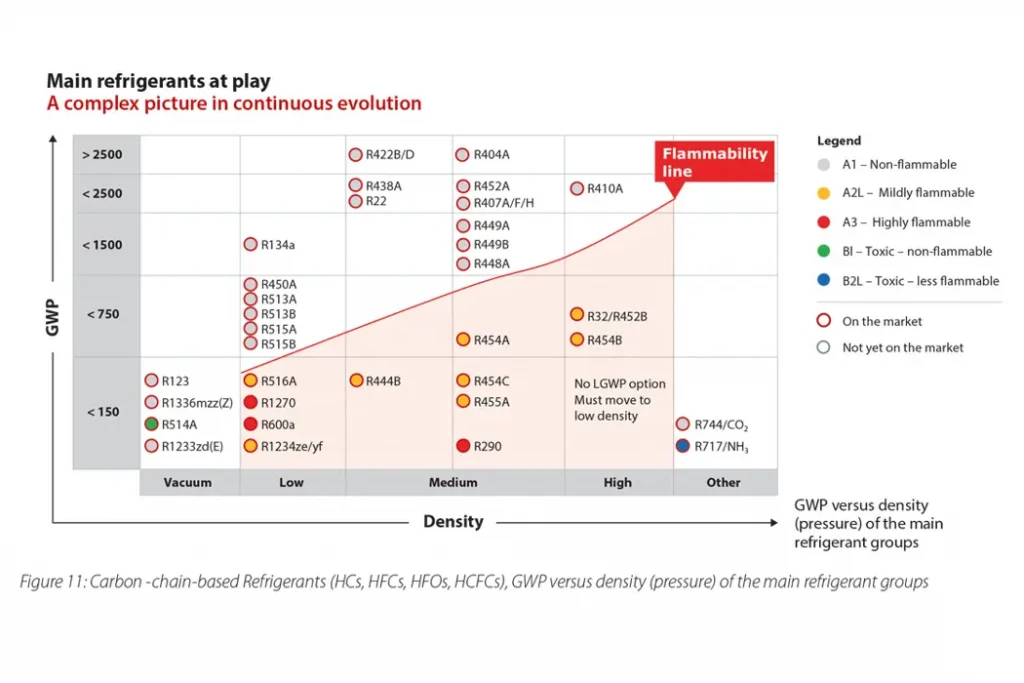Refrigerants keep our buildings cool, but when they leak, they become a major driver of climate change. The U.S. Environmental Protection Agency (EPA) estimates that refrigerant leaks contribute over 10% of greenhouse gas emissions, making them a powerful but often overlooked climate risk. Addressing these emissions through better management is one of the fastest ways to reduce the carbon footprint of the built environment.
Commissioning Across the Lifecycle
Managing refrigerants effectively starts with how HVAC systems are planned, installed, and maintained:
- Commissioning (new systems): Ensures equipment runs efficiently from day one and prevents leaks from poor installation.
- Retro-commissioning (existing systems): Optimizes older equipment, typically cutting energy use by ~15% while reducing leak risk.
- Decommissioning (end-of-life systems): Guarantees refrigerants are safely recovered and disposed of, preventing harmful releases.
A lifecycle approach reduces emissions while extending system efficiency and reliability.
Transitioning to Low-GWP Refrigerants
Not all refrigerants have the same climate impact. Traditional hydrofluorocarbons (HFCs) can be hundreds to thousands of times more potent than CO₂. Fortunately, lower Global Warming Potential (GWP) options are increasingly available:
- HFOs: Low-GWP synthetic alternatives
- Natural refrigerants: CO₂, ammonia, and hydrocarbons
- R-32: Commonly replacing R-410A in residential HVAC, with far lower GWP
Shifting to these refrigerants is essential for long-term climate goals.

Regulation and Industry Trends
The Kigali Amendment to the Montreal Protocol mandates a global phasedown of high-GWP refrigerants, driving innovation and new standards. In response, the industry is advancing:
- Leak detection technologies to identify even small emissions
- Natural refrigerant adoption across commercial and residential systems
- Training programs to equip technicians for safe handling and compliance
These efforts reflect the sector’s commitment to sustainability and resilience.
ESG Relevance of Refrigerant Management
Refrigerant strategy is more than an engineering issue — it’s a pillar of ESG performance:
- Environment: Preventing leaks and switching to low-GWP refrigerants reduces emissions and improves sustainability metrics.
- Social: Proper training improves technician safety and ensures better indoor air quality for occupants.
- Governance: Compliance with international standards like Kigali demonstrates accountability, credibility, and proactive risk management.
Challenges and Solutions
Key challenges include:
- Detecting small, persistent leaks
- Retrofitting older systems to meet modern standards
- Closing the workforce training gap
Solutions are emerging:
- Advanced sensors that pinpoint leaks early
- Educational programs for technicians
- Best practice retrofits that cut both leaks and energy waste
Together, these steps reduce operational risk while supporting long-term sustainability.
In Summary
Effective refrigerant management is one of the fastest wins for HVAC sustainability and building decarbonization. Organizations can start today by:
- Auditing systems for leak risks
- Training staff in safe handling and maintenance
- Installing modern leak detection technologies
- Planning the transition to low-GWP refrigerants
Each action cuts emissions, lowers costs, and strengthens ESG performance. With regulatory momentum and industry innovation accelerating, refrigerant management is no longer optional — it’s a climate and business imperative.
